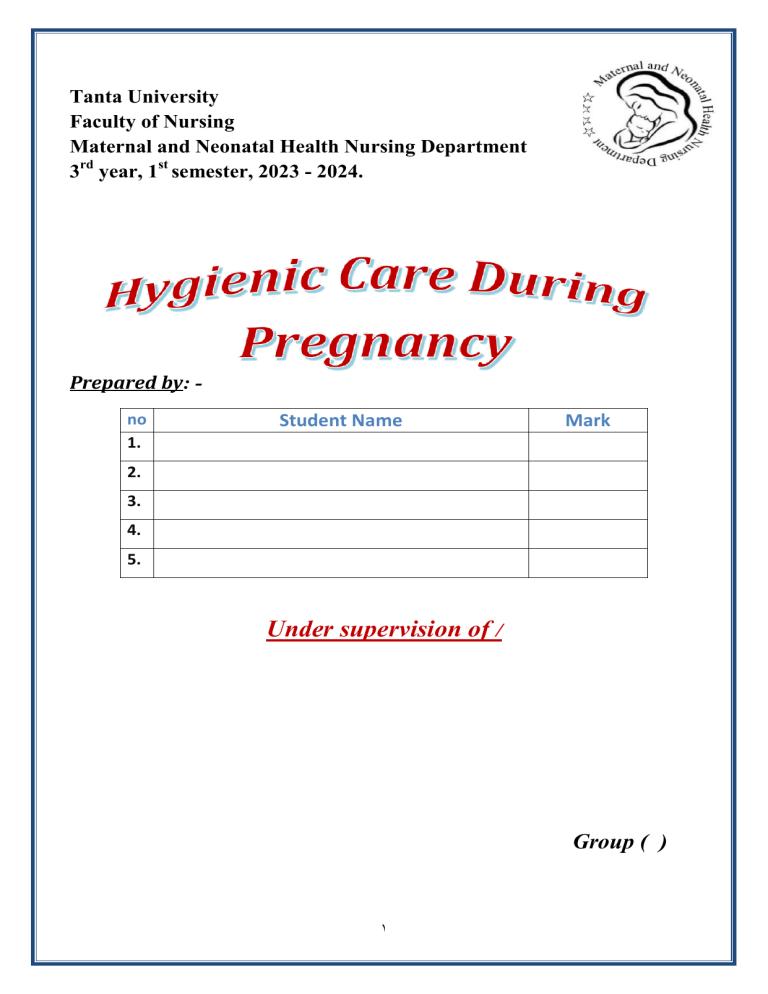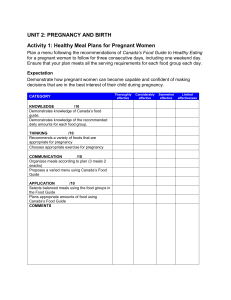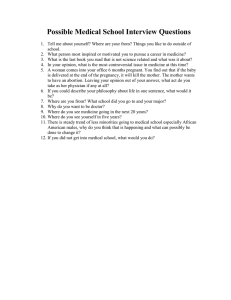
Tanta University Faculty of Nursing Maternal and Neonatal Health Nursing Department 3rd year, 1st semester, 2023 - 2024. Prepared by: no 1. Student Name Mark 2. 3. 4. 5. Under supervision of / Group ( ) 1 رؤية الكلية-: االثذاع وانتًُض ػهً انًغتىي انًحهٍ وااللهًٍُ فٍ يجبالد انتؼهُى وانتؼهى وانجحج انؼهًٍ وخذيخ انًجتًغ وتًُُخ انجُئخ. رسالة الكلية-: تغؼً كهُخ انتًشَط –جبيؼخ غُطب انً ثُبء ثُئخ اكبدًَُخ فبػهخ تؤدٌ انً تخشَج كىادس يهُُخ يتًُضح فٍ ػهىو انتًشَط لبدسح ػهً انًُبفغخ فٍ عىق انؼًم ػهً انًغتىي انًحهٍ وااللهًٍُ وتغبهى فٍ تمذَى انخذيبد انصحُخ نهًجتًغ ودفغ يغُشح انجحج انؼهًٍ انًجتكش فٍ اغبس لُى وتمبنُذ انًجتًغ ورنك يٍ خالل ثشايج تؼهًُُخ حذَخخ وفك يؼبَُش اكبدًَُخ يؼتًذح. رؤية ورسالة قسن توريض صحة األم وحذيثي الوالدة للعام الجاهعي 2223-2222 رؤية القسن: َتطهغ لغى تًشَط ايشاض انُغبء وانتىنُذ انً اٌ َكىٌ يٍ االلغبو انؼهًُخ انًتًُضح ػهً يغتىي انكهُخ يٍ خالل اػذاد يًشض ويًشظخ يتًُضٍَ لبدسٍَ ػهً انًُبفغخ انفؼبنخ فٍ ػصش تكُىنىجُب انًؼهىيبد. رسالة القسن: َغؼً لغى تًشَط ايشاض انُغبء وانتىنُذ انً اكغبة انطالة انًؼهىيبد وانًهبساد واالتجبهبد االَجبثُخ انالصيخ وانتٍ تًكُهى يٍ تمذَى سػبَخ تًشَعُخ يتطىسح فٍ يجبل صحخ انًشاح وحذَخٍ انىالدح وثزنك َغبهى فٍ تطىَش يهُخ انتًشَط وخذيخ انًجتًغ وتًُُخ انجُئخ كًب اٌ انمغى َغبػذ ػهً تًُُخ وتشجُغ انمذساد انتؼهًُُخ وانجحخُخ انًجُُخ ػهً االدنخ وانجشاهٍُ نذي انطالة واػعبء هُئخ انتذسَظ ثًب َتىاكت يغ احتُبجبد انًجتًغ. اهذاف القسن َهذف انمغى انً تمذَى ثشايج تؼهًُُخ يٍ شبَهب اػذاد كىادس يٍ انطالة لبدسح ػهً تمذَى سػبَخ تًشَعُخ شبيهخ نهًشاح ثًختهف انًشاحم انؼًشَخ وػهً جًُغ يغتىَبد انصحخ وانًشض يجُُخ ػهً تحهُم وتحذَذ االحتُبجبد انجغًبَُخ وانُفغُخ وانجُئُخ نهًشاح واالعشح وانًجتًغ.ورنك ثبعتخذاو انًؼهىيبد وانتمُُخ انحذَخخ وتطجُك َظشَبد واثحبث ػهىو انتًشَط وانؼهىو االعبعُخ واالجتًبػُخ واالَغبَُخ كبعبط نهًًبسعخ انتًشَعُخ انًهُُخ. * تتلخص اهذاف القسن فيوا يلي-: دساعخ انجىاَت انجغذَخ وانُفغُخ واالجتًبػُخ انًؤحشح فٍ حُبح انًشاح يٍ خالل-: دساعخ يحتىي انتششَح نهجهبص انتُبعهٍ انذاخهٍ وانخبسجٍ وػهى وظبئف االػعبء. 2 Objectives General objectives: At the end of this session the students will able to discuss hygienic care during pregnancy. Specific objectives: At the end of session the student will able to: 1) Define of hygienic care during pregnancy. 2) Enumerate importance of hygienic care during pregnancy. 3) Discuss nursing management to promote self-Care. 4) Describe techniques of fetal movement counts. 3 Outlines 1- Introduction. 2- Definition of hygienic care during pregnancy. 3- Importance of hygienic care during pregnancy . 4- Nursing management to promote self-Care includes the following: Personal hygiene. Perineal care. Medications. Substance abuse Immunizations. Breast Care. Dental Care. Clothing. Sleep and rest. Sexuality. Exercises. Travel. Employment. 5- Techniques of fetal movement counts. 6- References. 4 Introduction During pregnancy, women should be especially careful about personal hygiene. Pregnant women sweat more and have more vaginal discharge than non-pregnant women (due to hormonal changes), and they may be more vulnerable to infection by germs in the environment. Keeping the body clean helps prevent infection. Hand washing with soap is the most important hygiene action she can take, especially before preparing food and after going to the toilet. If possible, a pregnant woman should wash her body every day with clean water — especially her genital area. Dental hygiene is especially important during pregnancy because increased estrogen levels can cause swelling and increased sensitivity in gum tissues. Whether she cleans her teeth with a dental stick or a toothbrush and toothpaste, the pregnant woman should do so regularly. https://cdn2.momjunction.com/wp-content/uploads/2014/12/Hygiene-Tips-To-Follow-During-Pregnancy.jpg 5 Definition of hygienic care during pregnancy It's a comprehensive health supervision and special care given to pregnant woman during pregnancy till delivery to go through pregnancy, labor and puerperium without complication to mother and baby. Importance of hygienic care during pregnancy 1. To promote fetal and maternal health. 2. Early detection of any abnormality and try to lessen it by avoiding exposure to toxins or harmful agents. 3. To reduce maternal mortality and morbidity 4. Teaching the mother elements of personal care. 5. To promote healthy lifestyles that benefit both mother and child. Nursing Management to Promote Self-Care 1) Personal hygiene Hygiene is an essential for the maintenance of good health, cleaning the skin and removes dirty bacteria, sweat and body secretions. Women should take frequent shower to promote better hygiene. 2) Perineal care: The nurse must instruct pregnant women about the perineal care as follow: Perineal care after each elimination. Help to promote comfort. She should start cleaning from front to back to prevent contamination from anal area. 3) Medications: A pregnant woman should consult health care provider before taking any medication. Asprin & other drugs containing salicylates arenot recommended during preg nancy. 4) Substance abuse Increase the risk of gross structural fetal defects especially in first trimester during organogenesis. Nicotine in cigarettes cause vasoconstriction that alter maternal and fetal heart rate, blood pressure and cardiac output, low birth weight infant. 6 Alcohol, cocaine is associated with spontaneous abortion, preterm labor and IUGR. 5) Immunizations: Immunizations with live attenuated vaccine including mumps, rubella vaccine should not give during pregnancy because of teratogenic effect. Vaccinations with killed viruses including (varicella, hepatitis, influenza, and tetanus and diphtheria vaccine) may be given during pregnancy. Tetanus Toxoid (TT) vaccine given (0.5) ml intramuscular in the upper arm. Expected duration Dose When to give of protection TT1 After the first trimester of pregnancy. TT2 At least 4 weeks after TT1. TT3 Percent protection None 0% 1-3 years 80-85 % At least 6 months after TT2 or during subsequent pregnancy. At least 5 years 85-90 % TT4 At least one year after TT3 or during subsequent pregnancy At least 10 years 90-95% TT5 At least one year after TT4 or during subsequent pregnancy. For all childbearing years and possibly longer 95-99% 6) Breast care Inspect the breast to determine type of nipple and detect any abnormality. Wear a good supportive bra . Clean breast with warm water without soap on nipples (It dries out the nipples). Lubricate the dry nipple with olive oil. If women experience colostrum discharge, use breast pads inside the bra. Change as needed and allow nipples to air dry each time. Nipples are drawn for a short time daily by thumb and finger painted with lubricant during last 6 weeks. 7 7) Dental care A dental check up early in pregnancy and routine examination and cleaning are encouraged. Nausea and vomiting, heartburn and hyperemia of gums may lead to poor oral hygiene and dental caries. Brushing and flossing teeth twice daily will help reduce bacteria in the mouth, brush twice daily for 2 minutes, especially before bed, with fluoridated toothpaste and rinse well. 8) Clothing: Clothes should be non-constrictive. Low to mild heel shoes are recommended to avoid backache and poor balance. 9) Sleep and Rest: Getting enough sleep helps a person feel better and promotes optimal performance levels during the day. Eight hours at night and 2 hours in the afternoon. 10) Sexuality Sexual behavior is usually unrestricted in complication free pregnancies. Sexual desire may decrease during first trimester from discomfort and fatigue and may increase in second trimester when discomfort ware. Woman may have greater sexual satisfaction than before pregnancy because of vascular congestion of the pelvis Avoided if there is tendency to abortion or preterm labor and placenta previa. 11) Exercise: Exercises promote circulation and feeling of well being. Prenatal exercise increase muscle strength in preparation for delivery and promote restoration of muscle tone after delivery. Kegel exercise strengthens pelvic floor muscle and increase elasticity. Walking is considered the best exercise for pregnant woman. 8 12) Travel Safe during the first half of pregnancy but it is restricted in later months. It is not allowed if there a tendency to abortion or preterm labor. Air travel is better than train or care for long distances. Pregnant woman should travel with schedule periods of activity and rest. 13) Employment: Work sites should be checked for potential environmental hazards as pesticides, anesthetic gas as lead or mercury. Work duties should be altered to avoid excessive physical strain, rest periods needed to avoid fatigue. When riding car seat belt should be worn low under the abdomen. Routine antenatal visits Continuous prenatal care is important for a successful pregnancy outcome. The rec ommended follow-up visit schedule for a healthy pregnant woman is as follows: Every 4 weeks up to 28 weeks (7 months). Every 2 weeks from 29 to 36 weeks. Every week from 37 weeks to birth. Technique of fetal movement counts Quickening: the first fetal movements which are felt by the mother. Quickening often occurs between the 16th to the 22nd week of pregnancy. A multiparous woman might feel movements as early as 16 weeks, whereas a primi-parous woman may not feel anything until 20 to 22 weeks. At around 20 weeks of gestation, the trained healthcare provider can feel feta l movement externally through the abdomen. Clinicians often recommend starting counting fetal movement around 28 we e-ks gestation and continuing throughout the remainder of the pregnancy. 9 https://slideplayer.com/slide/13039672/ I. Cardiff (First) Technique: II. The woman lies or sits and concentrates on fetal movements until she records 10 movements. She must record the length of time during which the 10 movements occurred. She is instructed to notify her health care provider if she doesn’t feel at least 10 movements within 2-3 hour. Further follow-up testing is indicated. Sadovsky (Second) Technique: The woman lies down on her left side for 1 hour after meals and concentrates on fetal movement. Four movements should be felt within 1 hour. If four movements have not been felt within 1 hour, then the woman should monitor movement for a second hour. If after 2 hours four movements haven’t been felt, the client should contact her health care provider. 11 References 1- Boggess K. A., Urlaub D. M., Massey K. E., Moos M. K., Matheson M. B., & Lorenz C. Oral hygiene practices and dental service utilization among pregnant women. The Journal of the American Dental Association, 2019., 141(5); 553-561. 2- Hezelgrave N. L., Whitty C. J., Shennan A. H., & Chappell L. C. Advising on travel during pregnancy. Bmj, 2018; 342. 3- Dieb A. S., Shoab A. Y., Nabil H., Gabr A., Abdallah A. A., Shaban M. M., & Atti A. H. Perineal massage and training reduce perineal trauma in pregnant women older than 35 years: a randomized controlled trial. International Urogynecology Journal, 2018.,25(3); 1-7. 4- Pauleta J. R., Pereira N. M., & Graça L. M. Sexuality during pregnancy. The journal of sexual medicine, 2016;7(1), 136-142. 5- Velazquez M. D., & Rayburn W. F. Antenatal evaluation of the fetus using fetal movement monitoring. Clinical obstetrics and gynecology, 2017.,45(4), 993-1004. 11





